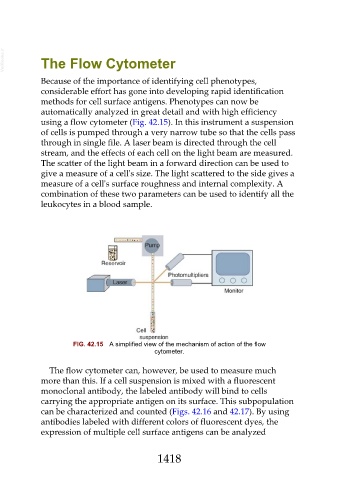Page 1418 - Veterinary Immunology, 10th Edition
P. 1418
VetBooks.ir The Flow Cytometer
Because of the importance of identifying cell phenotypes,
considerable effort has gone into developing rapid identification
methods for cell surface antigens. Phenotypes can now be
automatically analyzed in great detail and with high efficiency
using a flow cytometer (Fig. 42.15). In this instrument a suspension
of cells is pumped through a very narrow tube so that the cells pass
through in single file. A laser beam is directed through the cell
stream, and the effects of each cell on the light beam are measured.
The scatter of the light beam in a forward direction can be used to
give a measure of a cell's size. The light scattered to the side gives a
measure of a cell's surface roughness and internal complexity. A
combination of these two parameters can be used to identify all the
leukocytes in a blood sample.
FIG. 42.15 A simplified view of the mechanism of action of the flow
cytometer.
The flow cytometer can, however, be used to measure much
more than this. If a cell suspension is mixed with a fluorescent
monoclonal antibody, the labeled antibody will bind to cells
carrying the appropriate antigen on its surface. This subpopulation
can be characterized and counted (Figs. 42.16 and 42.17). By using
antibodies labeled with different colors of fluorescent dyes, the
expression of multiple cell surface antigens can be analyzed
1418

